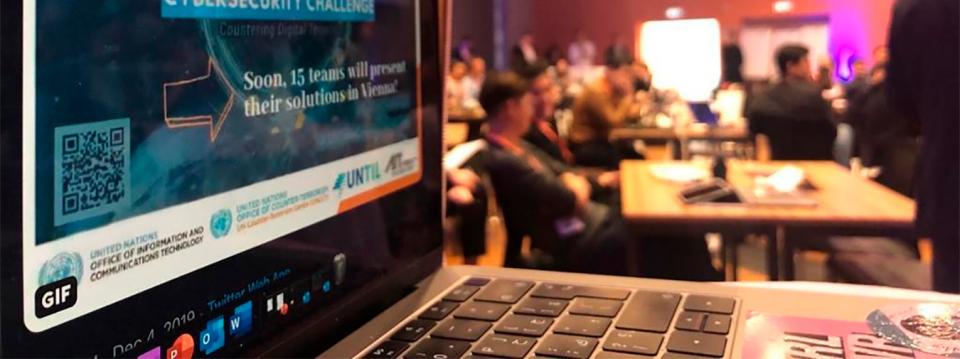网络安全

在网络挑战赛上, 15支年轻创新者团队在开发创意,从防止和打击暴力极端主义到尖端工具方面展示了解决方案并接受了专家指导。图片来源:反恐办公室
会员国表示“关切在全球化社会中,恐怖主义分子及其支持者越来越多地利用信息和通信技术,特别是因特网和其他媒体,并利用这些技术实施、煽动、招募、资助或策划恐怖主义行为”
——《全球反恐战略》的第六次审查
滥用技术发展
联合国反恐怖主义办公室在新技术领域内有若干举措。“网络安全和新技术”方案旨在加强会员国和私营组织防止和削弱恐怖主义分子和暴力极端分子滥用技术发展的能力。这包括在尊重人权的同时,应对恐怖主义分子对关键基础设施发动网络攻击造成的威胁,在尊重人权的同时, 开发利用社交媒体收集开源信息和数字证据,打击网络恐怖主义和暴力极端主义。
该方案还向关于恐怖主义分子使用无人驾驶航空系统(无人机)的国际论坛提供专门知识,并将进一步拟订这一领域的方案。该项目还谋求在发生此类攻击时减轻影响,修复和复原目标系统。
网络安全授权
在《全球反恐战略》的第六次审查(A/RES/72/284)期间,会员国对恐怖主义分子越来越多地利用信息和通信技术(信通技术),特别是互联网和其他媒体,以及利用这些技术实施、煽动、招募、资助或策划恐怖主义行为表示关切。会员国进一步注意到利益攸关方在实施《战略》方面开展合作的重要性,包括会员国、国际、区域和次区域组织、私营部门和民间社会之间的合作。
安全理事会在第2341(2017)号决议中呼吁会员国“酌情与公共和私营利益攸关方建立或加强国内、区域和国际伙伴关系,分享信息和经验,就针对关键基础设施的恐怖主义袭击所造成的损害开展防范、保护、减轻、调查、应对、复原工作,包括为此进行联合培训,使用或建立相关通信或紧急警报网络”。
马德里指导原则
安全理事会案文S/2015/939(马德里指导原则)通过了一套指导原则,用于阻止外国恐怖主义作战人员的流动:
“指导原则25:会员国应考虑审查本国立法,以确保通过特殊调查手段或通过目的地国收集的证据、或通过信通技术和社交媒体(包括电子监视)收集的证据可以在与外国恐怖主义战斗人员有关的案件中作为呈堂证据,同时尊重国际人权法(包括言论自由)”。
“指导原则26:会员国应建设国家执法机构内部的信通技术和法证能力和专门知识,并加强执法机构监测社交媒体中涉及恐怖主义的内容的能力,以符合各国国际人权义务的方式防止外国恐怖主义战斗人员的流动”。
安全理事会第2370(2017)号决议“敦促会员国合作采取行动,在尊重人权和基本自由并履行国际法义务的同时,防止恐怖主义分子通过信息和通信技术等途径获取武器,并强调指出在此努力中与民间社会和私营部门合作包括建立公私伙伴关系的重要性”。
Cybersecurity mandate
During the sixth review of the Global Counter-Terrorism Strategy (A/RES/72/284), Member States expressed concern at the increasing use by terrorists of information and communications technologies (ICT), in particular the internet and other media, and the use of such technologies to commit, incite, recruit for, fund or plan terrorist acts. Member States further noted the importance of cooperation among stakeholders in the implementation of the Strategy, including among Member States, international, regional and sub regional organizations, the private sector and civil society.
In resolution 2341 (2017), the Security Council Calls upon Member States “to establish or strengthen national, regional and international partnerships with stakeholders, both public and private, as appropriate, to share information and experience in order to prevent, protect, mitigate, investigate, respond to and recover from damage from terrorist attacks on critical infrastructure facilities, including through joint training, and use or establishment of relevant communication or emergency warning networks.”
Madrid guiding principles
Security Council text S/2015/939 (Madrid guiding principles) adopts a set of guiding principles to stem the flow of foreign terrorist fighters (FTFs):
Guiding principle 25: Member States should consider reviewing national legislation to ensure that evidence collected through special investigative techniques or from countries of destination or evidence collected through ICT and social media, including through electronic surveillance, can be admitted as evidence in cases related to foreign terrorist fighters, while respecting international human rights law, including freedom of expression”.
Guiding principle 26: Member States should build ICT and forensic capacities and expertise within national law-enforcement agencies and strengthen the capacity of law-enforcement agencies to monitor social media content related to terrorism in order to prevent the flow of foreign terrorist fighters in a manner that is compliant with the international human rights obligations of States”
Security Council resolution 2370 (2017) “urges Member States to act cooperatively to prevent terrorists from acquiring weapons, including through information and communications technologies, while respecting human rights and fundamental freedoms and in compliance with obligations under international law, and stresses the importance of cooperation with civil society and the private sector in this endeavour, including through establishing public private partnerships”.

